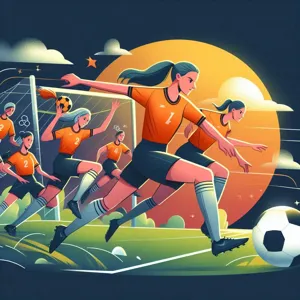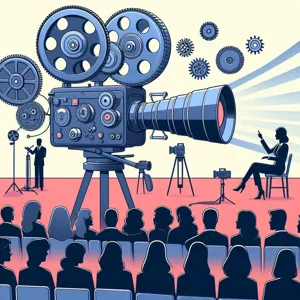Soccer, often referred to as the beautiful game, has the power to unite and inspire, yet women have historically faced significant barriers to fully engaging in this dynamic sport.
Despite the growing popularity of women’s soccer and the incredible achievements of female athletes on the global stage, many obstacles still hinder participation at various levels—from grassroots initiatives to professional leagues. In this blog post, we will explore effective strategies designed to kick down these barriers and empower women to take their place on the field. From fostering inclusive community programs and creating accessible training opportunities to advocating for equal funding and visibility, we will delve into actionable steps that can help cultivate a vibrant and diverse soccer culture. Join us as we champion the cause of women in soccer and pave the way for future generations to thrive in this exhilarating sport.
1. Introduction: The State of Women’s Soccer Today

In recent years, women’s soccer has witnessed a remarkable surge in popularity, yet it still grapples with significant barriers that hinder its full potential. From grassroots initiatives to professional leagues, women’s soccer has made strides in terms of visibility and participation, but the road ahead remains challenging. At the grassroots level, young girls are increasingly lacing up their cleats, inspired by the success of female athletes on the international stage. Iconic moments, such as the U.S. Women’s National Team’s triumphs in the FIFA Women’s World Cup, have catapulted women’s soccer into the spotlight, providing a powerful source of motivation for the next generation of players.
However, these achievements coexist with systemic issues that create obstacles for women in the sport. Disparities in funding, media coverage, and resources compared to their male counterparts continue to undermine the growth and development of women’s soccer. Many local clubs struggle to secure sponsorships, resulting in fewer opportunities for training and competition. Additionally, societal perceptions about women in sports can dissuade young girls from pursuing their passion, reinforcing stereotypes that have long been entrenched in the sporting world.
In this landscape, it is imperative to recognize both the progress made and the challenges that persist. By understanding the current state of women’s soccer, we can devise strategies to dismantle these barriers, ensuring that all aspiring female players have the opportunity to thrive. This blog post will explore various approaches to boost participation among women in soccer, highlighting the importance of community support, infrastructure development, and advocacy for equitable practices within the sport. Join us as we kick down barriers and pave the way for a more inclusive and vibrant future in women’s soccer.
2. Understanding the Barriers: Cultural and Social Factors
Understanding the barriers that hinder women’s participation in soccer involves delving into the complex interplay of cultural and social factors that shape perceptions and opportunities in the sport. In many communities, traditional gender roles still dictate what activities are deemed appropriate for women and girls, often relegating sports like soccer to a male-dominated sphere. These cultural norms can dissuade families from encouraging their daughters to engage in soccer, viewing it as an unsuitable or even unladylike pursuit.
Moreover, the lack of representation in media and public discourse further exacerbates these barriers. When young girls see few female role models in soccer—whether as players, coaches, or commentators—it’s easy for them to internalize the message that the sport isn’t meant for them. This is compounded by the often limited access to quality training programs and facilities tailored for girls, which can create an environment where they feel unwelcome or unsupported.
Social dynamics also play a crucial role. In many regions, peer pressure can discourage girls from participating in soccer, especially if their friends or classmates do not share the same interest. This can lead to a cycle where the absence of female players perpetuates the belief that soccer is not for girls. Additionally, issues such as bullying or harassment within sports settings can deter participation, making the soccer field feel like a hostile environment rather than a place for empowerment and growth.
To effectively kick down these barriers, it is essential to engage communities in conversations about the value of women’s participation in soccer. By fostering inclusive environments, promoting female role models, and ensuring that girls have equal access to resources and opportunities, we can begin to dismantle the cultural and social factors that have historically limited their involvement in the sport. Only through understanding and addressing these barriers can we create a more equitable playing field for future generations of female soccer players.
3. Promoting Grassroots Programs: Building a Foundation

Promoting grassroots programs is the cornerstone of enhancing women’s participation in soccer, laying a solid foundation for future generations of players. These programs serve as essential platforms that not only introduce the sport to young girls but also cultivate a nurturing environment where they can develop their skills, confidence, and passion for the game. By initiating programs in local communities, schools, and recreational centers, we can create accessible pathways for girls to engage with soccer from an early age.
Imagine a bustling park on a Saturday morning, filled with the laughter and excitement of young girls donning their vibrant jerseys, eagerly gathering for practice. These grassroots initiatives can take various forms, from organized league play and skill-development clinics to summer camps and school-based activities. The emphasis should be on inclusivity and fun, ensuring that every girl, regardless of her skill level, feels welcomed and supported.
Moreover, involving female coaches and mentors in these programs is vital. Female role models can inspire young players, showing them what is possible and helping them navigate the challenges they may face in a traditionally male-dominated sport. By fostering a sense of community and connection, grassroots programs can empower girls to dream big and nurture their love for soccer.
Investment in these initiatives also yields long-term benefits for the sport itself. As more girls participate, the talent pool will grow, leading to increased competition and a richer soccer culture. Ultimately, promoting grassroots programs is about more than just the game; it’s about building a supportive network that champions girls’ sports, instills life skills, and inspires a lifelong love for soccer. With a strong foundation laid through these programs, the future of women’s soccer looks brighter than ever.
4. Increasing Visibility: Media Representation and Coverage
Increasing visibility through media representation and coverage is a vital strategy for boosting women’s participation in soccer. For far too long, women’s soccer has been relegated to the shadows of the sporting world, often overshadowed by its male counterparts. However, as societal attitudes shift and the demand for equality grows, the media plays a crucial role in shaping perceptions and fostering interest in women’s soccer.
To improve visibility, media outlets must commit to providing comprehensive coverage of women’s leagues, tournaments, and player achievements. This includes broadcasting matches, offering in-depth analysis, and highlighting the stories of female athletes. When young girls see their heroes celebrated on television or in print, it ignites a spark of possibility. They begin to envision themselves on the pitch, dribbling past defenders and scoring goals, inspired by the very women they see on screen.
Moreover, social media platforms present an unparalleled opportunity to amplify women’s soccer. Engaging content—such as behind-the-scenes clips, player interviews, and interactive live streams—allows fans to connect with players on a personal level, fostering a sense of community and encouragement. Hashtags and viral challenges can further enhance visibility, encouraging grassroots participation and drawing attention to local clubs and events.
The impact of increased media representation cannot be overstated. When women’s soccer is given the same spotlight as men’s, it not only legitimizes the sport but also encourages investment at all levels, from grassroots initiatives to professional leagues. Sponsorships and partnerships with brands that prioritize gender equality can further elevate the game, ensuring that women’s soccer receives the funding and recognition it deserves.
In conclusion, by prioritizing media representation and coverage, we can break down the barriers that have historically limited women’s participation in soccer. It is time to celebrate female athletes and their achievements, making them visible role models for the next generation of soccer players. When women are seen, heard, and celebrated, the path to participation becomes clearer and more inviting for all.
5. Support from Schools: Integrating Soccer into Physical Education

Integrating soccer into physical education programs within schools is a crucial step toward increasing women’s participation in the sport. Schools serve as the foundational building blocks of a child’s development, and introducing soccer as a core component of physical education can cultivate a lifelong passion for the game. When girls see soccer as a regular part of their school curriculum, they are more likely to engage with it, develop their skills, and build confidence on the field.
To effectively implement this integration, schools can adopt a comprehensive approach that includes organized soccer sessions, skilled coaching, and an inclusive atmosphere that encourages participation regardless of skill level. By incorporating soccer drills, practice matches, and friendly competitions into the curriculum, educators can create an environment that not only promotes physical fitness but also fosters teamwork, discipline, and leadership among young girls.
Furthermore, the involvement of female coaches and role models in these programs can have a transformative impact. When girls see women leading soccer activities, it breaks down stereotypes and demonstrates that women can excel in sports, inspiring them to pursue their own goals within the game. Collaborating with local soccer clubs to provide resources, equipment, and coaching expertise can enhance school programs and ensure that they are engaging and effective.
In addition, schools should consider hosting soccer-themed events, such as tournaments or “soccer days,” that invite families and the community to participate. These events not only showcase the girls’ talents and achievements but also create a supportive network that encourages continued involvement in soccer. By making soccer a visible and valued part of the school culture, we can kick down barriers and empower the next generation of female athletes to lace up their cleats and take to the field with confidence.
6. Engaging Communities: The Role of Local Clubs and Organizations
Engaging communities is a cornerstone strategy for boosting women’s participation in soccer, and local clubs and organizations play a pivotal role in this initiative. These grassroots entities are not just about organizing games; they serve as essential hubs that foster inclusivity, build camaraderie, and create a supportive environment for female players of all ages.
Local clubs can actively reach out to underrepresented groups, providing tailored programs that address specific barriers to entry, such as lack of access to equipment, transportation, or coaching. By offering free clinics, workshops, and trial sessions, clubs can lower the intimidation factor, allowing newcomers to engage with the sport in a welcoming, pressure-free setting. This hands-on approach not only demystifies the game but also encourages women and girls to step onto the pitch, forming a sense of belonging within the community.
Organizations that partner with schools and community centers can enhance visibility and access, ensuring that soccer is not just an elite sport but a popular choice for all. By hosting events that celebrate local female players and showcasing their achievements, these clubs can inspire the next generation, creating role models who resonate with young girls. Moreover, incorporating mentorship programs where experienced players are paired with newcomers can cultivate a nurturing atmosphere, allowing for skill development and personal growth.
Engaging local businesses as sponsors can further amplify these efforts, providing resources for uniforms, equipment, and travel expenses, thus alleviating financial barriers. When communities rally around their local clubs, it creates a vibrant soccer culture that champions women’s participation, paving the way for a future where playing soccer is as natural and accessible for girls as it is for boys. By leveraging the power of local clubs and organizations, we can create a powerful network of support that not only encourages women to play but celebrates their contributions to the beautiful game.
7. Empowering Coaches: Training and Development for Women

Empowering coaches is a fundamental strategy to enhance women’s participation in soccer, as these individuals play a pivotal role in shaping the experience and development of female athletes. Providing specialized training and development opportunities for women coaches not only equips them with essential skills but also fosters a supportive environment where they can thrive and inspire their players.
Investing in women-centric coaching programs is crucial. These programs should focus on honing technical skills, leadership abilities, and tactical knowledge, all while addressing the unique challenges women may face in the coaching landscape. Offering mentorship opportunities with experienced coaches can create a robust support network that encourages women to pursue coaching roles confidently.
Additionally, creating a culture of inclusivity within training sessions and clinics can empower female coaches to share their experiences and insights. This collaborative environment promotes knowledge exchange and helps women coaches build a sense of community, which is vital for their growth and retention in the sport.
Moreover, recognizing and celebrating the achievements of women coaches can serve as a powerful motivator for aspiring coaches. Highlighting success stories through social media campaigns, workshops, and community events not only raises awareness but also showcases the impact of female coaches on the game. By elevating their visibility, we inspire a new generation of women to step into coaching roles, ultimately leading to a more diverse and inclusive soccer landscape.
Empowering coaches through targeted training and development initiatives will not only enhance their skills but also create a ripple effect, encouraging more girls and women to participate in soccer. When female coaches are visible, respected, and supported, they become role models for aspiring players, fostering a thriving ecosystem that benefits the entire sport.
8. Creating Safe Spaces: Addressing Harassment and Discrimination
Creating safe spaces within the world of soccer is not just a necessity; it’s a fundamental right that every female player and fan deserves. Addressing harassment and discrimination is crucial to fostering an inclusive environment where women can thrive both on and off the field. This starts with acknowledging the issues that have historically plagued women’s sports, such as misogyny, bullying, and unequal treatment.
To combat these challenges, organizations and teams must implement comprehensive policies that clearly define unacceptable behaviors and establish zero tolerance for harassment. Training programs for coaches, players, and staff should focus on promoting respect and understanding, equipping them with the tools to recognize and intervene in situations of discrimination. Furthermore, creating anonymous reporting systems can encourage victims to come forward without fear of retaliation, ensuring that their voices are heard and respected.
Physical spaces also play a critical role in creating a safe environment. Fields, locker rooms, and facilities should be designed with women’s needs in mind, providing adequate resources and privacy. Additionally, community programs that encourage open dialogue about these issues can help raise awareness and foster solidarity among players and fans alike.
By prioritizing the creation of safe spaces, we empower women to participate fully in soccer, driving not only their personal growth but also the overall advancement of the sport. When women feel safe, respected, and valued, they are more likely to engage, excel, and inspire the next generation of female soccer players. Ultimately, addressing harassment and discrimination isn’t just about changing attitudes; it’s about transforming the culture of soccer to one where every woman can kick down barriers and play freely.
9. Leveraging Sponsorships: Funding Opportunities for Women’s Teams
Sponsorships have become a critical lifeline for women’s soccer, providing the financial backing necessary to elevate teams and leagues to new heights. As the popularity of women’s soccer continues to surge, brands are increasingly recognizing the untapped potential in sponsoring female athletes and teams. This presents an exciting opportunity to not only fund essential resources but also to cultivate a sustainable ecosystem where women’s soccer can thrive.
To leverage sponsorships effectively, teams must first identify potential partners whose values align with their mission. Companies that prioritize diversity, inclusion, and community engagement are often eager to support women’s sports initiatives. By crafting tailored proposals that highlight the benefits of their investment—such as increased brand visibility, access to new markets, and the opportunity to connect with passionate fan bases—teams can attract lucrative sponsorship deals.
Moreover, creating engaging content that showcases the team’s journey, achievements, and community impact can amplify sponsorship appeal. Sharing inspiring stories through social media, newsletters, and local events can draw attention not only from potential sponsors but also from fans and community members. This storytelling approach helps to humanize the brand and foster a deeper connection with the audience—an essential element for any successful partnership.
Additionally, teams should explore innovative sponsorship models, such as multi-year contracts, grassroots initiatives, or co-branded campaigns. By thinking outside the box and demonstrating how sponsorships can yield mutual benefits, teams can build lasting relationships with brands invested in uplifting women’s sports.
In this era of increased visibility and support for women’s soccer, the potential for sponsorships is immense. By actively seeking and nurturing these funding opportunities, teams can break down financial barriers, invest in talent development, enhance training facilities, and ultimately elevate the level of play. This not only leads to better performance on the field but also inspires the next generation of female athletes to dream big and pursue their passion for soccer.
10. Role Models and Mentorship: Inspiring the Next Generation
In the world of sports, role models and mentorship play a pivotal role in shaping the aspirations of young athletes, particularly for women in soccer. The visibility of successful female players can ignite passion and ambition in girls who may otherwise believe that soccer is not a pathway for them. By showcasing the journeys of trailblazers like Megan Rapinoe, Alex Morgan, and Sam Kerr, we not only celebrate their achievements but also provide tangible examples of what is possible.
Creating mentorship programs that connect young players with experienced athletes can further deepen this impact. Imagine a young girl stepping onto the field with the knowledge that she has someone to look up to, someone who has faced and overcome similar challenges. These mentors can offer advice, encouragement, and support, instilling confidence in the next generation. Whether it’s through organized clinics, one-on-one coaching sessions, or informal meet-and-greets, these connections can be transformative.
Additionally, community events that feature prominent female soccer players can serve as both inspiration and education. Hosting workshops or Q&A sessions where young athletes can interact with their idols allows them to see firsthand the dedication and hard work that goes into becoming a top player. It also reinforces the message that success in soccer is not merely a dream; it’s an achievable goal.
Furthermore, integrating stories of female athletes into school curricula and community programs can help to normalize women’s participation in sports. By highlighting their contributions and achievements, we can reshape perceptions and encourage more girls to pick up a soccer ball instead of shying away from it.
Ultimately, fostering a culture of mentorship and providing relatable role models are powerful strategies to encourage women’s participation in soccer. By inspiring young girls to take to the field and showing them that they belong there, we can create a brighter future for women’s soccer, one where every girl feels empowered to chase her dreams.
11. Advocating for Equal Opportunities: Policy Changes and Support
Advocating for equal opportunities in soccer is not just a moral imperative; it’s a powerful strategy to enhance women’s participation in the sport. Policy changes at every level, from grassroots organizations to professional leagues, play a crucial role in dismantling the barriers that have historically sidelined female athletes.
For instance, sports governing bodies can implement policies that mandate equal funding for women’s teams and programs, ensuring that resources are allocated fairly. This includes not only financial support but also access to facilities, coaching, and training opportunities. By championing initiatives that prioritize equality, we can create an environment where young girls feel empowered to pursue soccer with the same vigor as their male counterparts.
Moreover, support from influential figures in the sport—coaches, players, and even sponsors—can amplify advocacy efforts. When established athletes and organizations publicly endorse equal opportunities, it sets a precedent and encourages others to follow suit, fostering a culture of inclusivity. Campaigns that highlight the achievements of women in soccer can also serve as a rallying cry, inspiring young girls to envision themselves in similar roles.
It’s essential to engage with local communities to understand their unique challenges and tailor policies that address these needs. This might involve advocating for girls’ teams in schools, providing scholarships for aspiring female players, or facilitating mentorship programs where experienced athletes guide the next generation.
Ultimately, advocating for policy changes and support is about creating a sustainable ecosystem where women’s soccer can thrive. By breaking down systemic barriers and fostering an inclusive culture, we can ensure that every girl has the opportunity to lace up her cleats and step onto the field, contributing to a richer, more diverse soccer landscape.
12. The Importance of Inclusivity: Making Soccer Accessible for All
Inclusivity is the cornerstone of a thriving soccer community, where every individual—regardless of gender, background, or ability—feels welcomed and valued. Making soccer accessible for all not only enriches the sport but also cultivates a diverse landscape that reflects the society we live in. To boost women’s participation in soccer, it is crucial to break down the barriers that often prevent them from engaging in the game.
One of the key strategies to enhance inclusivity is to establish programs tailored specifically for women and girls. This can include free or low-cost clinics, workshops, and leagues that encourage participation at all levels, from recreational play to competitive teams. Partnering with local schools and community organizations can help identify and reach out to those who may not have previously considered soccer as a viable option. By providing opportunities for skill development in a supportive environment, we empower women to take the field with confidence.
Moreover, accessibility goes beyond just creating programs; it also encompasses the physical and social environments in which soccer is played. Ensuring that fields and facilities are well-maintained, safe, and located in areas that are easy to reach can significantly impact participation rates. Additionally, fostering a culture of respect and inclusion on and off the field is vital. This involves training coaches and officials to understand the dynamics of gender inclusivity and encouraging positive interactions among players, families, and fans.
Visibility is another powerful tool in promoting inclusivity. Highlighting female role models through media coverage, community events, and social media campaigns can inspire young girls and women to see themselves as part of the soccer narrative. Celebrating the achievements of women in soccer—be it players, coaches, referees, or administrators—can create a ripple effect, encouraging more to get involved.
Ultimately, making soccer accessible for all requires a collective effort from clubs, organizations, and communities. By embracing inclusivity, we not only boost women’s participation but also enrich the sport as a whole, paving the way for a future where soccer truly belongs to everyone.
13. Success Stories: Case Studies of Effective Programs
Success stories serve as powerful testimonies to the potential of well-structured programs in enhancing women’s participation in soccer. By examining successful initiatives around the globe, we can glean valuable insights and strategies that have led to increased engagement and empowerment among female players.
One standout example is the “Girls On The Run” program in the United States, which merges physical activity with life skills. Although primarily focused on running, the program incorporates soccer into its curriculum, encouraging girls to participate in a sport that fosters teamwork and confidence. Through mentoring and community support, participants not only develop athletic skills but also build resilience and self-esteem, paving the way for a lifelong love of sports.
Across the Atlantic, the Football Association in England has implemented the “Game Changer” initiative. This program is dedicated to increasing female representation at all levels of the sport, from grassroots to professional. By focusing on coaching education specifically designed for women and creating pathways for female coaches and referees, the initiative has effectively dismantled barriers and fostered a more inclusive sporting environment. The results are evident: a significant increase in registered female players and a more diverse coaching landscape.
In South America, the “Fútbol Femenino” program has made strides in empowering women through soccer in countries like Brazil and Argentina. By providing resources and funding specifically for women’s teams, this program has not only elevated the visibility of women in soccer but has also nurtured local talent through community-based leagues. The success of these leagues has inspired girls to take up the sport, proving that investment in women’s soccer yields tangible results.
These case studies reveal that success in boosting women’s participation in soccer hinges on community engagement, targeted resources, and fostering an environment that celebrates female athletes. By studying these effective programs, other organizations can replicate strategies that have proven successful, ultimately leading to a brighter and more inclusive future for women in soccer.
14. Call to Action: How Everyone Can Contribute
As we strive to break down barriers and elevate women’s participation in soccer, it’s essential to recognize that every individual has a role to play in this transformative journey. Whether you’re a seasoned player, a coach, a fan, or simply someone passionate about equality in sports, your contribution can make a significant impact.
First and foremost, **advocacy is key**. Speak up about the importance of women’s soccer in your community. Attend games, cheer for local teams, and engage in conversations about women’s sports. Social media is a powerful tool—share stories, highlight achievements, and celebrate victories of female athletes to inspire others and raise awareness.
Moreover, **support local initiatives**. Volunteer your time or resources to organizations that promote women’s soccer. Whether it’s coaching young girls, organizing events, or donating equipment, your involvement can help create a nurturing environment where young athletes feel empowered to pursue their passion.
In addition, consider **sponsoring or promoting women’s teams**—this can range from financial support to simply helping them gain visibility in local media. When businesses and communities endorse women’s soccer, it sends a strong message that these athletes deserve the same recognition and resources as their male counterparts.
Lastly, **encourage inclusivity** within your circles. Invite friends and family to games, engage them in discussions about the sport, and inspire them to get involved. By fostering a welcoming atmosphere and creating opportunities for women in soccer, we can collectively kick down barriers and pave the way for future generations.
Change begins with us, and by taking these steps, we can ensure that women’s soccer not only survives but thrives, creating a rich tapestry of talent, passion, and camaraderie that benefits everyone involved. Let’s rally together to make a difference on and off the field!
15. Conclusion: The Future of Women’s Soccer and Continued Efforts
As we look to the future of women’s soccer, it is clear that the momentum generated in recent years is just the beginning. The surge in popularity, driven by passionate athletes, groundbreaking television coverage, and an ever-growing fanbase, signals a transformative era for the sport. However, to truly kick down barriers and ensure that women’s soccer flourishes, continued efforts are essential.
Investing in grassroots programs is vital to nurturing young talent. From providing accessible training facilities to ensuring that girls have the same opportunities as boys in schools and clubs, these initiatives lay the foundation for a new generation of athletes. Coaches and mentors play a crucial role in this development, and their engagement can inspire confidence and passion in aspiring players.
Moreover, fostering a supportive culture within soccer communities is imperative. This means promoting inclusivity and diversity, ensuring that all women—regardless of background or skill level—feel welcomed and valued. It’s about creating environments where girls can play freely, express themselves, and form lasting friendships through the beautiful game.
At the professional level, continued advocacy for equal pay and sponsorship opportunities will amplify the impact of women’s soccer. As more companies recognize the value of investing in women’s sports, we can expect to see enhanced visibility and resources, further propelling the game forward. Additionally, media coverage must prioritize women’s matches, highlighting not just the sport’s competitiveness, but also the inspiring stories of the athletes behind it.
In conclusion, the future of women’s soccer is bright, but it requires ongoing commitment and collaboration from all stakeholders—fans, players, coaches, and sponsors alike. By investing in the present and advocating for equality, we can build a thriving ecosystem where women’s soccer not only survives but thrives, inspiring future generations and solidifying its place in the global sports arena. Together, we can ensure that the barriers that once held women back are dismantled, paving the way for a game that is inclusive, empowering, and exhilarating for all.
As we conclude our exploration of strategies to boost women’s participation in soccer, it’s clear that creating an inclusive and supportive environment is essential for the growth of the game. By addressing barriers such as access, representation, and resources, we can pave the way for a new generation of female players who are empowered to pursue their passion for soccer. The journey towards equality in sports requires collective effort—from grassroots organizations to professional leagues, from coaches to parents—and every step we take matters. Let’s commit to championing initiatives that promote inclusivity, celebrate diversity, and inspire young girls to lace up their cleats and embrace the beautiful game. Together, we can kick down barriers and transform the landscape of soccer, ensuring that every player has the opportunity to shine on the field.

















